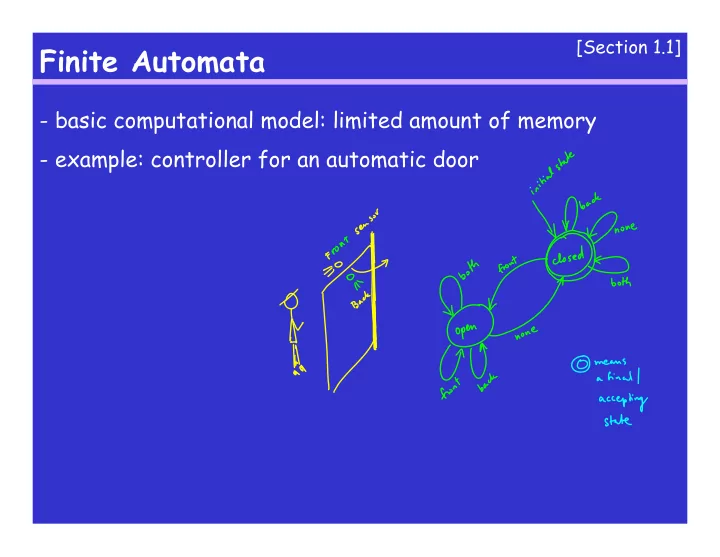

[Section 1.1] Finite Automata - basic computational model: limited amount of memory - example: controller for an automatic door
[Section 1.1] Finite Automata Formal definition: A finite automaton (FA) is a 5-tuple (Q, Σ , δ ,q 0 ,F), where - Q is a finite set of states - Σ is a (finite) alphabet - δ :Qx Σ Q is the transition function - q 0 ∈ Q is the start state - F ⊆ Q is the set of accept states Pictorial representation: state diagram
[Section 1.1] Finite Automata Formal definition: A finite automaton (FA) is a 5-tuple (Q, Σ , δ ,q 0 ,F), where - Q is a finite set of states - Σ is a (finite) alphabet - δ :Qx Σ Q is the transition function - q 0 ∈ Q is the start state - F ⊆ Q is the set of accept states Pictorial representation: state diagram
[Section 1.1] Finite Automata Another (more abstract) example: - accept all strings over {0,1} that start with 1 and end with 0
[Section 1.1] FA: computation & language Let M=(Q, Σ , δ ,q 0 ,F) be a FA. The language of M ( accepted / recognized by M) is L(M). Formally: need the definition of computation : M accepts w=w 1 w 2 …w n if there exist states r 0 ,r 1 ,…,r n in Q such that - r 0 = ? - δ - r n A language is regular if there exists a FA that recognizes it.
[Section 1.1] Designing FAs Examples – languages over {0,1} consisting of strings: - with odd number of 1’s - that contain 001 as a substring - that are even length and do not contain 00 as a substring A language that cannot be accepted by a FA?
[Section 1.1] Designing FAs A language that cannot be accepted by a FA?
[Section 1.1] Regular operations Let A and B be languages. The following three language operations are called the regular operations : - union : A ∪ B - concatenation : A.B - star : A * The natural numbers are closed under multiplication but not division. What about the class of regular languages ?
[Section 1.1] Regular languages are closed under … Thm 1.25: The class of regular languages is closed under the union operation.
[Section 1.1] Regular languages are closed under … Thm 1.25: The class of regular languages is closed under the union operation.
[Section 1.1] Regular languages are closed under … Thm 1.26: The class of regular languages is closed under the concatenation operation.
Recommend
More recommend